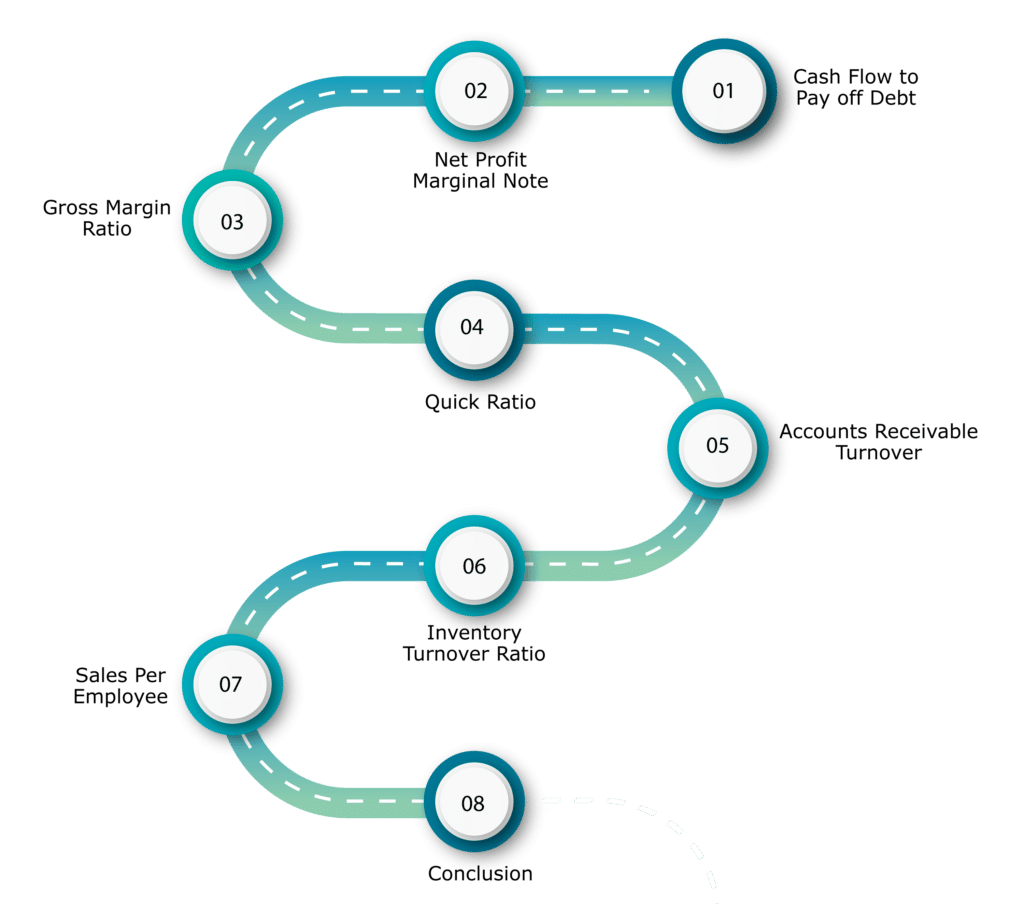
7 Crucial Financial Ratios For A Business
When you are looking at the financial numbers on your statements can be a daunting experience. The reason for this is that a large amount of data makes it hard to determine which is the best indicator of the health of your business.
This is why the importance of understanding various financial ratios to your business comes into play. This article is designed to provide the seven most vital financial ratios for a business.
Financial Ratios - Meaning
The financial ratios for a business are a measurement of the relation between two or more components or even two parts in the financial statements of a company. These financial ratios for a business will ensure that you can monitor efficiency easily, detect problems and provide proactive solutions.
It doesn’t matter if you travel an inch or miles, you will keep track of all financial transactions in your company’s accounting records. The financial ratios for a business aid in making sense of the accounting data that your company’s books contain.
Ratios assist in identifying and understanding the elements of your business that are effective as well as those that might not be performing. They also help in understanding where you stand against your competition. It allows you to determine the profit or gains you’ve made and the weak points.
Investors and lenders rely on these ratios to evaluate the performance of the company. Thus, the Financial Ratios for a business are an important performance indicator, or KPI, as you might refer to it. The ratios are based on information available within the review of the financial statement.
Significance of Measuring Financial Ratios For A Business
They are vital for conducting quantitative analysis. A few ratios are used to calculate the short and long-term, operational and financial performance. It helps identify trends within the organization and gives warning signs or signals when it’s time to alter the plan.
In addition, if the company wants to seek outside financing via an investor, or bank, these numbers can provide individuals with the information needed to determine whether the business is in a position to repay the funds and generate a high return on the investment.
Usage of Financial Ratios For A Business
The financial ratio for a business can be utilized in two ways:
Firms Analyzing Performance This can be assessed by using the trend analysis, which calculates an individual’s ratio, on a per-term basis and tracking the amount over some time. This analysis can help determine the reason for the receivables that are pending, their average duration of collection, and also a decline in the company’s liquidity.
Relative Performance Comparative The comparison compares the company’s earnings and those of its competitors.
Important Financial Ratios For A Business

We’ve compiled seven of the most crucial financial ratios for a business that you should be tracking to help your business.
Cash flow to pay off debt
A majority of the money in the financial ratio for a business is used to pay off debts. This cash flow to debt ratio can be very beneficial because poor cash flow can hinder main businesses, especially small ones. The debt issue doesn’t appear to be an issue of liquidity until the date for repayment is set.
You might have borrowed funds for business-related reasons however, you might be forgetting that you must repay the loan before the deadline when the due date arrives. You realize there isn’t enough cash flow.
The financial ratios for businesses can utilize the cash flow to debt ratio that will allow them to monitor the flow of cash. It’s possible to notice that a cash flow debt ratio lower than 1 indicates that you might not be able to pay your expenses without additional cash.
Net profit Marginal note
This is the percentage of your income that remains after subtracting operating costs, taxes, and interest. Many investors look at net profit margin because it indicates how efficient the company is in managing expenses and turning revenues into profit.
A lower net profit margin could be a sign that various issues must be attended to. The reason for this could be that sales are declining due to poor customer service. There is a chance that you’re not monitoring consumable office equipment or another issue.
However, an excessive net profit margin means that the product has been properly priced and you’re able to exercise prudent cost control.
Gross margin ratio
If the company is selling items, this is a vital aspect that demands your pay attention to. This ratio is a reflection of the amount of money that remains at your disposal to cover operating expenses after you have paid for the product that you’re offering.
The financial ratios for a business can be calculated by product or for the entire business. For example, the gross margin could be determined by the value of a particular product. The greater your gross margin is, the greater money you’ll have to cover other expenses of a business. A low gross margin means that you could have difficulty financing the operating costs.
Quick ratio
The next test is then the ratio of quick. This also pertained to the acid test. This ratio can help businesses that have current liabilities, such as the accounts to be paid and short-term loans and payroll taxes that have to toe paid, income tax to be paid as well as credit card debt and many other expenses.
The quick ratio of the financial ratios for a business evaluates liquidity and lets you know whether you have enough current assets to meet the current obligations. If your fast ratio lies on the high side, you’re more placed. If the quick ratio is below 1.0 the debts you have to exceed your assets. Therefore, you must be able to pay off your debt and save cash in the beginning.
It is important to note that this percent stage doesn’t count inventory from your assets at present, because inventory isn’t easily changed in cash.
Accounts Receivable Turnover
Turnover in accounts receivables helps bear in mind how well the financial ratio for a business is receiving its money.
Cash flow is a problem for companies, especially small ones. Receiving payments on time can make a corporation feel relaxed about its cash situation. If your turnover in account receivables begins to extend it indicates that you just must take time to figure out the receivables process.
Inventory Turnover Ratio
The term “inventory turnover rate” will be wont to determine how often inventory was changed into sales in an exceedingly specific time. Therefore, it may be helpful to the financial ratio for businesses that manage inventory.
It is calculated by quarter, month, or maybe by year. A high percentage of turnover signifies that the company is continually changing its inventory. The businesses with stable inventory are likely to possess a greater inventory ratio than those that have dearer and non-perishable stock.
When calculating the inventory turnover ratio, you can identify if they’re spending money on storage or if they are tying the cash to an inefficient or unsalable inventory. A large number of investors use this to gauge how liquid the inventory of a business is since inventory is among the largest assets that the retailer has to report on its balance statement.
If the inventory cannot be taken off the market, it’s ineffective for the company. The financial ratios for a business are also used by creditors since the inventory is usually designated as collateral for loans.
If you are looking for additional funding for your business, whether it’s either an investor outside or a micro-businesses loan think about taking a look at the ratio of your inventory turnover and enhancing the financial ratios for a business.
Sales per employee
If the sales of a company’s per-employee financial ratios for a business are high, it indicates that the company is effective in managing its resources. This is an excellent measure to determine the most essential business-related decision.
If the sales of a company per employee are rising the financial ratio for a business is growing at a rapid rate. If it’s not, it is important to determine if it’s a temporary issue or whether the business’s operations aren’t running effectively as they ought to or should.
Looking for an Expert Guidance?
Get 30 minutes of free consultation
with our company formation experts!
[contact-form-7 id=”7244″ title=”Blog interction form”]
Conclusion
In terms of financial metrics, it is important to be aware that a business may not be assessed correctly using only one ratio. So, you must use several ratios in utilizing to help you make better investment decisions.
If you’re still having questions regarding the financial ratios for a business or any other question, we are ODINT Consultancy. We’re we are here to assist you at each step of your way.
FAQ’s
- Quick ratios are financial ratios for a business measure that is used to assess the company’s liquidity. This ratio can also be referred to in the form of the acid test.
- The quick ratio is a comparison of the total value in cash or cash equivalents plus account receivables and marketable securities to the total amount of current obligations.
- Example of Quick Ratio of financial ratios for a business
If a company’s cash and cash equivalents + marketable securities + accounts receivable adds up to $1,000,000 and the amount of the company’s current liabilities is $1,200,000, its quick ratio is 0.83 to 1. - It differs from the current ratio because certain current assets are not included in the ratio. The primary current asset excluded is the inventory.
- The gross margin ratio (or gross profit) is the percentage of gross sales divided by gross profit.
- Companies must monitor their gross margin ratio continuously to ensure it is sufficient to cover their selling, general and administrative expenses, interest expenses, as well as to make a profit.
- Example of Gross Margin Ratio of financial ratios of a business
To illustrate the administrative rest expenses assume that a company has net sales of $800,000.

